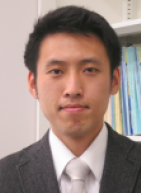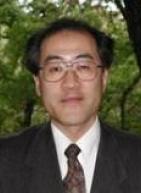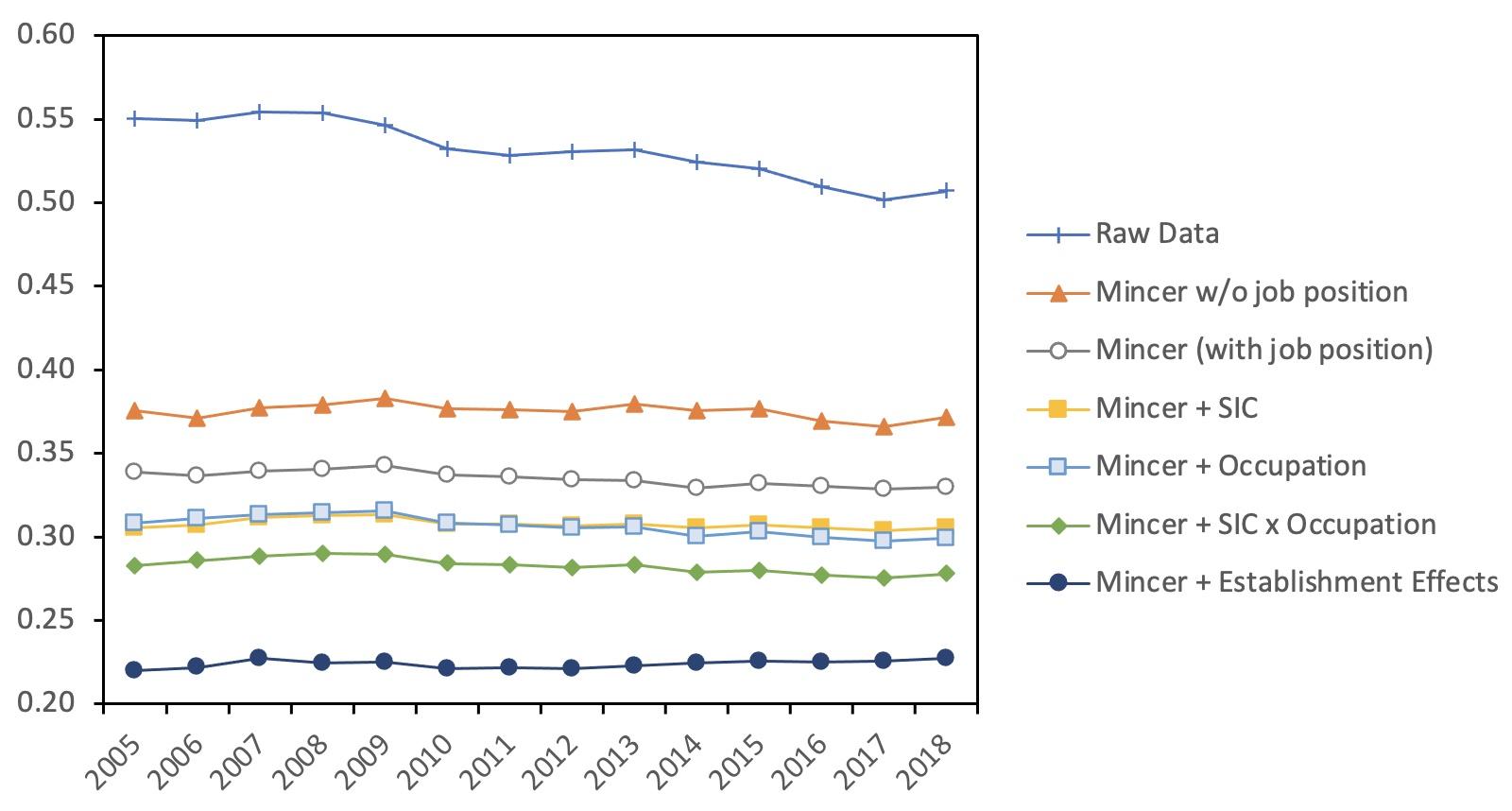In contrast to many developed economies that are considered comparable (such as the US), wage inequality in Japan has remained relatively stable in recent decades (Kambayashi et al. 2008, Lise et al. 2014). One of the reasons behind this stability has been identified as a substantially flat college education wage premium, mainly as a result of the rapid increase of college graduates (Kawaguchi and Mori 2016). Aggregate trends, however, might not be able to tell the whole story if heterogeneity in wage inequality exists at lower levels. Recent research has shown that a remarkable share of observed wage inequality can be explained by factors specific to the employer. While the majority of these papers link firms’ characteristics to their propensity to provide higher remuneration in general, an interesting minority of them investigates how the heterogeneity of firms explains gaps in the remuneration of different groups of workers within the firm (e.g. Aghion et al. 2019, Cirillo et al. 2017, Card et al. 2013).
In a new paper (Ikeuchi et al. 2021), we contribute to this strand of the empirical literature by studying whether some variability of the college wage gap in Japan can be tracked to the firm level and which employer-specific characteristics drive this heterogeneity. We focus in particular on two firm attributes that seem particularly relevant and meaningful for Japan: (1) establishment size, and (2) workforce composition in terms of regular/non-regular employees. The first can be associated to many factors that are able to shape within-firm wage dispersion, such has the stringency of labour market institutional settings (Kambayashi and Kato 2016), the complexity of hiring and compensation policies, and the strategic and organisational structure which drives demand for different types of workers (Araki et al. 2016). The increase in non-standard employment in the last three decades has been one of the major labour market evolutions in Japan, which has shaped a strong duality (OECD 2019) and contributed to weakening the Japanese employment system, traditionally based on the role of seniority (lifetime employment system). At the firm level, the second attribute of heterogeneity we consider (share of regular workers) is directly related to technological factors (Fukao and Perugini 2021) and to the importance of knowledge accumulation (Dosi et al. 2021), which define the firm’s competitive environment and its human resources management approach.
College wage gap within firms in Japan
To investigate the association between firms’ characteristics and the college wage gap, we rely on the data from the Basic Survey on Wage Structure (BSWS), conducted by the Japanese Ministry of Health, Labour, and Welfare (MHLW). Our dataset refers to the years 2005-2018, for which detailed information on the type of employment (regular/non-regular work) is available. The sample is composed of 13,142,691 dependent workers, employed in 609,330 establishments. We identify regular workers as those holding a full time, permanent job position.
In Figure 1 we report the evolution of the adjusted education wage gaps obtained by plotting the regression coefficients of education dummies from year-by-year Mincer equations (controlling for individual wage drivers and augmented with occupation and establishment dummies). Compared to the benchmark group (senior high school education), average wages of junior high school-educated workers have been increasing significantly. However, consistent with previous evidence (Kawaguchi and Mori 2016) the distance between wages of university graduates and senior high school graduates has remained virtually unchanged, amounting to approximately 12%. The same holds for the wage gap between senior high school and junior college graduates (around 4%).
Figure 1 Adjusted education wage gap in Japan, 2005-2018
Source: Own elaborations from BSWS (MHLW, Japan) data
Following Card et al. (2013), we compare a measure of dispersion in actual (raw data) hourly wages to the dispersion of various residual wages. Residual wages are extracted from (log) wage regression models estimated on an annual basis. For each year we start by estimating a Mincer equation and, in every following step, we include an additional set of explanatory variables (job position, sector, etc.). In Figure 2, the change in the level of dispersion of wages due to the inclusion of each set of right-hand variables indicates its relative importance in explaining overall wage variability. Obviously, the most important role in explaining wage variability is played by the drivers normally appearing in Mincer-type equations (gender, age, age squared, experience, tenure, and education). However, once these factors and job characteristics are controlled for, the inclusion of establishment effects (the distance to the bottom line) plays a particularly relevant role, confirming that the firm-level dimension of wage inequality in Japan deserves attention.
Figure 2 The components of wage dispersion in Japan, 2005-2018
Source: Authors’ elaborations from BSWS (MHLW, Japan) data
Establishment size, workforce composition, and college wage gap
Our econometric estimates rely on a two-step method similar to Winter-Ebmer and Zweimuller (1999) and Cirillo et al. (2017). The approach relies on the use of adjusted individual wages to construct an establishment-level wage inequality metric. Adjusted individual wages are obtained as the residuals of a wage regression estimated on an annual basis and describe the part of the individual wage that is not explained by personal characteristics of the workers (age, education, etc.) or by the general tendency of firms to pay high/low wages. Hence, the residual is the component of individual wages that differs between observationally identical individuals who work in the same establishment and captures the effect of unobservable workers’ characteristics that generate a wage premium/penalty (such as innate abilities/disabilities or quality of the education received, which shape higher productivity and/or bargaining power). The residual is then used to compute and compare, within each establishment and for each year, the average adjusted wage for workers with different education (university versus senior high school graduates). This measure of the within-establishment college wage gap is then used, in a second stage, as the dependent variable in an establishment level equation, which includes size and share of regular workers as dependent variables. Potential issues related to omitted variable bias and endogeneity are addressed by instrumental variable (IV) and propensity score methods.
Our results clearly indicate that larger establishments exhibit higher (adjusted) wage differences between university graduates and senior high school graduates. Similarly, a larger share of regular workers is associated with a larger college wage gap. Larger establishments and those more intensively using regular contracts are able to employ highly educated workers, who are better endowed, compared to the medium educated, with unobservable characteristics (such as innate abilities, the quality of education received, superior work ethic) that are remunerated with a wage premium above market average.
This evidence is consistent with the conjecture, based on the available literature and evidence, that (1) larger establishments have organisational and compensation policies that allow them to attract and keep ‘better’ highly educated employees, which is crucial to operating in complex and competitive environments; and (2) having a high share of regular workers is an indicator that companies have productive environments in which the accumulation of specific knowledge plays a key role and the attraction of high quality employees for top occupations is crucial to firms’ success.
While there is no previous evidence on the impact of workforce composition on wages of different education levels for Japan, our results on the effects on firm size are in line with the idea that large gaps in talent and innate ability exist across workers in different firm-size groups, as suggested by the fact that graduates of top-ranked universities are much more likely to be employed by large firms in Japan (Fukao 2018).
Conclusions
Our results indicate that size and composition of the workforce (by regular/non-regular employment) are good candidates as explanations of within-firm college wage gaps, as they are able to describe productive environments with different capacities to attract and keep highly educated employees with (non-observable) better characteristics in terms of delivering firm success. Future extensions of our research include enriching the dataset with matched employer-employee information, which will provide a longitudinal structure of the sample (of establishments) and a richer set of control variables at firm level, including those that describe major trends shaping labour demand (such as technology, R&D, IT and intangible capital intensity, and internationalisation patterns). This will contribute, from a different angle, to the ongoing debate on the factors shaping wage inequality and, ultimately, income inequality.
Authors’ note: The main research on which this column is based first appeared as a Discussion Paper of the Research Institute of Economy, Trade and Industry (RIETI) of Japan.
References
Aghion, P, A Bergeaud, R Blundell and R Griffith (2019), “The Innovation Premium to Soft Skills in Low-Skilled Occupations”, CEP Discussion Papers 1665, Centre for Economic Performance, LSE, London.
Araki, S, D Kawaguchi and Y Onozuka (2016), “University prestige, performance evaluation, and promotion: Estimating the employer learning model using personnel datasets”, Labour Economics 41:135–148.
Card, D, J Heining, and P Kline (2013), “Workplace Heterogeneity and the Rise of West German Wage Inequality”, The Quarterly Journal of Economics 128(3): 967-1015.
Cirillo, V, M Sostero and F Tamagni (2017), “Innovation and Within-Firm Wage Inequalities: Empirical Evidence from Major European Countries”, Industry and Innovation 24(5): 468-491.
Dosi, G, D Guarascio, A Ricci and M E Virgillito (2021), “Neodualism in the Italian Business Firms: Training, Organizational Capabilities and Productivity Distributions”, Small Business Economics 57: 167-189.
Fukao, K (2018), “Stagnation and the Labor Market in Japan”, in J Cohen-Setton, T Helbling, A S Posen and C Rhee (eds.), Sustaining Economic Growth in Asia, Chapter 7, Peterson Institute for International Economy, Washington, DC.
Fukao, K and C Perugini (2021), “The Long-Run Dynamics of the Labor Share in Japan”, The Review of Income and Wealth 67(2): 445-480.
Ikeuchi, K, K Fukao and C Perugini (2021), "Establishment Size, Workforce Composition and the College Wage Gap in Japan", RIETI Discussion Paper 21-E-022, Rieti, Tokyo.
Kambayashi, R, D Kawaguchi and I Yokoyama (2008), “Wage Distribution in Japan, 1989-2003”, Canadian Journal of Economics 41(4): 1329-1350.
Kambayashi, R and T Kato (2016), “Long-Term Employment and Job Security over the Past 25 Years: A Comparative Study of Japan and the United States”, Industrial and Labor Relations Review 10(2): 359-394.
Kawaguchi, D and Y Mori (2016), “Why has Wage Inequality Evolved so Differently between Japan and the US? The Role of the Supply of College-Educated Workers”, Economics of Education Review 52: 29–50.
Lise, J, N Sudo, M Suzuki, K Yamada and T Yamada (2014), “Wage, income and consumption inequality in Japan, 1981-2008: From boom to lost decades”, Review of Economic Dynamics 17: 582–612.
OECD (2019), OECD Economic Survey: Japan 2019, OECD Publishing, Paris.
Winter-Ebmer, R and J Zweimüller (1999), “Intra-firm Wage Dispersion And Firm Performance”, Kyklos 52(4): 555–572.







